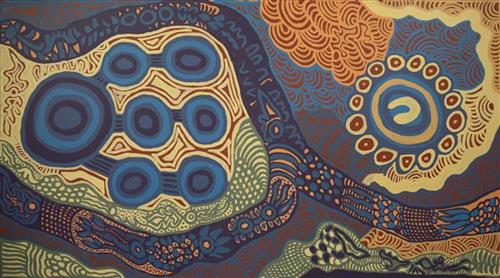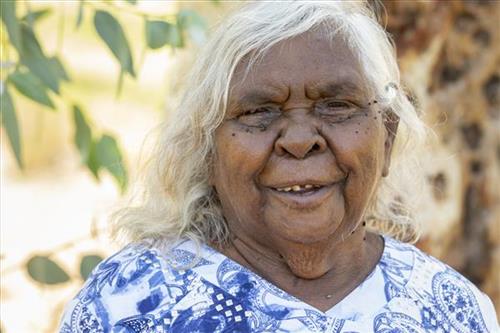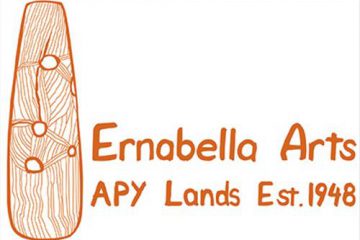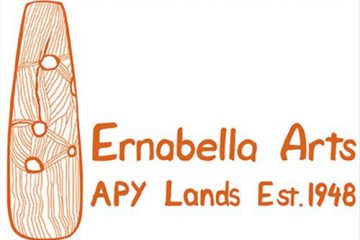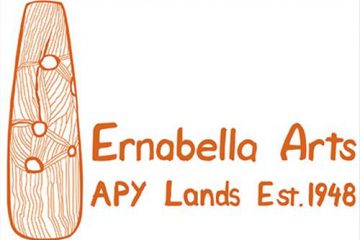Biography:
Tjunkaya grew up at the Ernabella Mission. In those days the building which is now the art centre was originally used as a food hall. In 1948 it became the Craft Room. There was a sheep station attached to the Mission and the first work made by the aṉangu ladies was hand spinning the fleece into wool and then looming it into floor rugs, weavings and wall hangings. Most of the senior artists painting on the Aṉangu Pitjantjatjara Yankunytjatjara (APY) Lands today have passed through this building in one of its many incarnations.
Tjunkaya began working in the Craft Room as a young girl, learning from her mother and other family members. She started making weavings and moccasins with the now instantly recognisable motif known as Anapalaku Walka or the Ernabella Design. In the 1970’s the Ernabella artists were introduced to the technique of batik and Tjunkaya quickly excelled in the creation of these delicate designs on silk. She became an outstanding batik artist and her work is held in several public collections. One of her batik’s was featured on the cover of Judith Ryan's Across the Desert: Aboriginal Batik from Central Australia.
In 2003 the Ernabella Arts screen-printing space was converted into a dedicated ceramics studio and once again Tjunkaya quickly became a leading artist in this new medium. The artists had started to move away from illustrating with walka (design) and were now focusing on sharing their Tjukurpa – sacred stories of law, Country and culture.
Today Tjunkaya tells two main stories in her works on both canvas and ceramics. Part of the significant songline Kungarangkalpa (Seven Sisters) travels through the APY Lands and Tjunkaya is one of the few people authorised to share this story.
The concept of Nintintjaku means to teach, show or pass down. As well as being an artist, Tjunkaya is a senior and highly regarded cultural custodian, and she has published many works in her language, Pitjantjatjarra. Tjunkaya encapsulates Nintintjaku in her work by telling figurative stories of traditional ways of life and passing on names and information of native foods, medicine, plants and animals.
Tjunkaya is also a highly skilled and accomplished tjanpi (fibre) artist and one of her most delightful and important works is housed in the National Portrait Gallery. In 2022 she was the Cultural Director and lead artist creating fibre artworks for Tjanpi Desert Weaver’s short film about the infamous Ernabella donkeys. Tangki Tjuta (Many Donkeys) won Best Animation and also the Craft Award at the Sydney Film Festival. Tjunkaya also provided the Pitjantjatjarra text for the accompanying book that won the NT Chief Minister’s Book Award for Children.
Tjunkaya is a multi-talented artist working across a variety of mediums that also include punu (wood), print making and mukata (beanies). Her work in all these different forms has been shown in numerous exhibitions in Australia and internationally and in public and private galleries since 1971. Her works are held in many collections here and overseas including the National Gallery of Australia, National Museum of Australia, National Museum of Scotland and the Museum of Ethnology in Japan.
Since 2010 Tjunkaya has chosen to concentrate on painting, ceramics and tjanpi sculpture. This focus has seen her become one of the most in demand female artists on the APY Lands and increasingly recognised in these mediums.
Tjunkaya is a four-time finalist in the National Aboriginal and Torres Strait Islander Art Awards (NATSIA, the Telstras) and she has had solo exhibitions at Alcaston Gallery in Melbourne and Sabbia Gallery in Sydney.
Tjunkaya has been on the Board and the Deputy Chair of Ernabella Arts, and the leader of the Nintintjaku Project, an inter-generational teaching project with Ernabella Aṉangu School.
She has had essays published in a number of exhibition catalogues and monographs including Desert Mob and Tarnanthi: Festival of Contemporary Aboriginal and Torres Strait Islander Art.
In 2018 Tjunkaya’s life’s work as a representative for her people, an artist and a writer was recognised when she received the Gladys Elphick Award for Lifetime Achievement.
In 2020 Tjunkaya was awarded an Order of Australia in the Queen's Birthday Honours.
